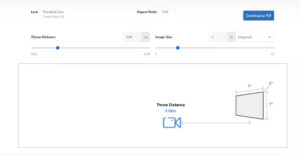Creating a home theater in a small apartment can be challenging, but it is entirely possible with the right planning and equipment. One of the most important decisions is choosing the correct projector screen size. Selecting the ideal projector screen size ensures that your viewing experience is immersive, comfortable, and visually appealing, even in limited spaces. A well planned setup can transform a small living room or bedroom into a cinematic environment without overwhelming the room.
Understanding Projector Screen Size
Projector screen size refers to the diagonal measurement of the projected image. Unlike televisions, projector screens are flexible and can be adjusted to fit the room dimensions, viewing distance, and personal preference. In small apartments, balancing screen size with available space is crucial. A screen that is too large can dominate the room and cause eye strain, while a screen that is too small may reduce the immersive experience and make details hard to see.
Factors to Consider for Small Apartment Screens
1. Room Dimensions
The size of your room directly influences the maximum projector screen size you can use. Measure the width, depth, and height of the space to determine how large your screen can be without interfering with furniture, doors, or windows. In small apartments, screens between 60 and 100 inches diagonal often provide a good balance of visibility and comfort.
2. Viewing Distance
Viewing distance is one of the most critical factors in determining screen size. In small apartments, seating is usually closer to the screen. The recommended viewing distance for HD content is roughly 1.5 to 2.5 times the screen height. For 4K projectors, viewers can sit closer, allowing for larger screens without losing image clarity. Proper distance ensures that images remain sharp and comfortable to watch.
3. Projector Resolution
The projector’s resolution affects how large you can go without losing clarity. Full HD projectors are suitable for moderate screen sizes, while 4K projectors can handle larger screens and still display crisp details. High resolution is especially important in small apartments where viewers may sit closer to the screen.
4. Aspect Ratio
Most projectors use a 16:9 aspect ratio, which is ideal for movies, TV shows, and gaming. Widescreen 2.35:1 aspect ratios are less common in small apartments as they require larger horizontal space. Choosing the correct aspect ratio ensures that content fits the screen properly without letterboxing or distortion.
5. Room Lighting
Ambient light affects image visibility. Darker rooms allow for larger screens and better contrast, while bright rooms may require smaller screens or higher brightness projectors to maintain image quality. Consider blackout curtains or adjustable lighting for the best viewing experience.
6. Wall or Ceiling Space
In small apartments, wall space may be limited. Ensure that the screen fits comfortably on the wall without blocking windows, doors, or furniture. Ceiling mounted projectors or retractable screens can save space and provide flexibility.
Calculating the Ideal Projector Screen Size
Step 1: Measure Viewing Distance
Determine the distance from the seating area to the screen location. This is the primary factor in selecting the correct screen size.
Step 2: Select Aspect Ratio
Choose 16:9 for most content. This ensures compatibility with streaming services, Blu rays, and gaming consoles.
Step 3: Apply Viewing Angle Guidelines
A comfortable viewing angle is essential for small apartments. For HD content, maintain a viewing angle of 30 to 40 degrees. For 4K content, you can go up to 60 degrees without noticeable pixelation.
Step 4: Verify Projector Capabilities
Check the projector’s throw ratio to ensure it can project the desired screen size from the available distance. Ultra short throw projectors are ideal for small apartments where space is limited.
Step 5: Adjust for Room Constraints
Ensure that the screen size fits your wall or available space without causing obstruction. Leave room for furniture, speakers, or other equipment.
Practical Tips for Small Apartment Home Theaters
1. Use Ultra Short Throw Projectors
Ultra short throw projectors allow large images from a short distance. They are perfect for small apartments because they reduce the need for long throw distances and minimize shadows caused by people moving in front of the projector.
2. Consider Portable or Retractable Screens
Retractable screens save space when not in use and allow flexibility in room setup. Portable screens can be moved or stored easily to optimize apartment space.
3. Optimize Room Lighting
Control ambient light with blackout curtains or dimmable lights. Darker rooms enhance contrast and allow you to use a slightly larger screen without washing out the image.
4. Calibration and Setup
Calibrate the projector for brightness, contrast, and color accuracy. Proper calibration ensures that the chosen screen size delivers sharp, vibrant images suitable for movies, gaming, or streaming.
5. Sound Optimization
In small apartments, audio can bounce off walls and create echoes. Position speakers carefully or consider soundbars and subwoofers that complement the projector screen size for a balanced audio visual experience.
Conclusion
Selecting the best projector screen size for a small apartment involves balancing room dimensions, viewing distance, projector resolution, and available wall space. Screens between 60 and 100 inches diagonal often work well in compact living spaces, providing a cinematic experience without overwhelming the room.
By carefully measuring your space, understanding projector capabilities, and choosing the correct aspect ratio, you can create an immersive home theater that fits perfectly in your apartment. A well planned projector setup transforms small spaces into cinematic environments, offering high quality visuals and an enjoyable viewing experience for movies, gaming, and entertainment.
Read more: https://inspirejournal.xyz/what-does-screen-size-mean-in-projectors/
